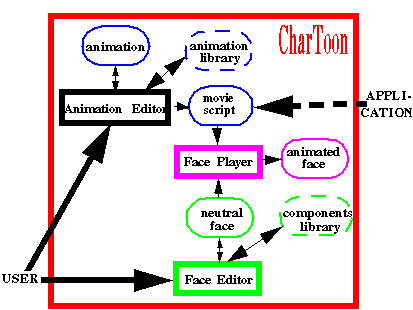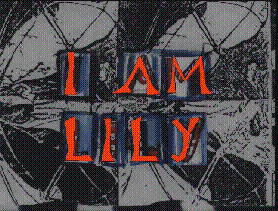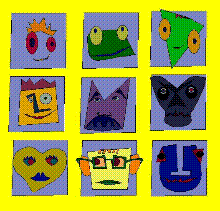 The CharToon System
The CharToon System
Preface on how to read this page
Most of the text and the pictures on this page
are to be shown on a poster at WWW9. Next to
the poster we wish to have a PC where movies, on-line demo of the CharToon
system as well as the web oriented Face Player Applet will be demonstrated.
Technical remarks
In order to run the , your browser must be prepared to
play Java applets. You need Java 1.1, which is the standard Java provided
with for example the Netscape 4.+ browser.
The are of MPEG-1 format, with video and audio streams, and can be played if a recent Mediaplayer plugin is available. You may download it for several platforms.
If you have technical problems, contact Bèhr de Ruiter: behr@cwi.nl
General contact person is Zsofi Ruttkay: zsofi@cwi.nl
In spite of the several different approaches in the past years to
provide avatars on the web, the slow download and/or extra plug-in needed
are common characteristics which have hindered the applicability of animated
faces on the web.
In order to overcome these drawbacks, we have developed CharToon, a
system in Java, with which one can design faces and animations, and then
play (ready-made or on-the-fly generated) animations real-time on the web,
using only a standard browser. CharToon is dedicated for facial designs,
but can be used to make other animations too.
 The CharToon System
The CharToon System
CharToon consists of 3 components:
Face Editor is a 2 1/2d drawing program with which one can define the structure, the geometry, the colours and the potential changes (in shape, position, size and visibility) of the features of a face.
Animation Editor is an interactive 'animation composing' program, to define the time-behaviour animation parameters of a drawing, provided by Face Editor. Animations can be saved as a script (for later re-use), or a movie script can be generated.
Face Player actually generates the frames of an animation, on the basis of the animation parameter values in the movie script file provided by Animation Editor and the face description file provided by Face Editor. The generated frames, if needed, can be used as input to make traditional movie files too. These programs exchange ascii data with each other and possibly with other programs outside CharToon.
How to design a face?
With Face Editor (see snapshot) one produces vector-based graphics extended with so-called control points. The position of control points can be changed when defining an animation. A face
is made by using basic building blocks (open or closed polylines and smooth
curves) which may connect control points, and compound ones which can change shape indirectly, according to changes of their skeleton. Protoptypes for facial features like a human mouth or
eye are provided. The user may extend the collection of complex, re-usable
components. A face is made by including components and editing them: changing
their appearance and/or modifying the dynamical potentials. There is also
the possibility to include images into the drawing. In Test mode one can
see the effect of dragging control points.
How to animate a face?
Animation Editor (see snapshot)
is a graphical editor which operates on a window which
looks like a musical score. There is a 'staff' for every animation parameter;
the lines on each staff reflect the values the parameter can take. The
behaviour in time of an animation parameter is specified by placing points
on its staff. In-between values are provided by linear interpolation. One can do cut
and paste operations and time- and value scaling on portions of curves
and on sets of them. Snapshot of the face and selection of the current
animation can be looked at while editing the animation. Pieces of animations
can be stored as ascii scripts and can be re-used; (ascii) movie scripts can be generated by sampling the curves at a chosen rate. There also is a facility to use audio channels and labels as aid for synchronisation.
How to show a face on the web?
Face Player can generate and show frames based on a movie script
file constructed by Animation Editor and a face file produced by Face
Editor. These both are small ascii files. Animated faces can be shown on
web pages by:
Besides downloading ready-made animations to drive Face Player, data generated on the fly (by some other software or the user) can be used too, making it possible e.g. to generate lip-synch for audio or exhibit emotional expressions on faces representing users. Scripts for Face Player can be generated in more sophisticated ways, e.g. depending on conditions what (expression) is to be shown - something which cannot be achieved with ordinary movies.
Ongoing work...
Demo movies
In order to see the demo MPEG-movies below,
your browser must be able to show MPEG-movies, either via a plug-in, or via a standalone
programme.
| Lily | Nine Faces |
 |
 |
|
Download lilly (5.27Mb)
Lily is a single subtly drawn cartoonish female face, with dynamic components to demonstrate how basic human expressions can be achieved by exaggerated and non-realistic features (e.g. change of face width). |
Download ninef (5.43Mb)
Nine Faces is a collection of 9 very stylistic human and non-human heads, which can be animated to exhibit some basic expressions and talking. The faces have 6-12 control parameters each. |
The Face Player Applet
If your browser can handle Java applets, written in Java 1.1,
then you can run our Face Player in the applet window below.
After the applet has been loaded and the first frame of the animation
(showing the face of 'JanReal') is present in the window, press the 'start' button.
For other movies: select a movie by double-clicking
on a movie-name in the menu, and then select 'start' again.
Please be patient ; downloading the java class library may take a while....